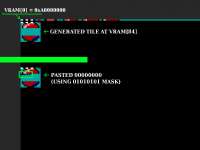I want to test some ideas in EGA video card but I can't find a lot of info about it.
For the moment I can load images to vram in mode 0D, to create a background, and now I want to draw sprites on top of it.
I know how to copy and restore the background every time a sprite is redrawn, but I don't really know whant's the fastest way to "paste" a sprite with transparent parts on top of the background.
In VGA I found some "compiled sprites" functions to draw the sprite, but I can't find anything like that for EGA.
Thanks.
For the moment I can load images to vram in mode 0D, to create a background, and now I want to draw sprites on top of it.
I know how to copy and restore the background every time a sprite is redrawn, but I don't really know whant's the fastest way to "paste" a sprite with transparent parts on top of the background.
In VGA I found some "compiled sprites" functions to draw the sprite, but I can't find anything like that for EGA.
Thanks.

